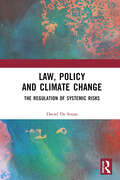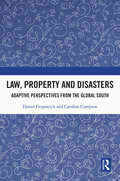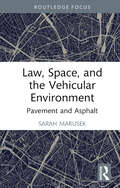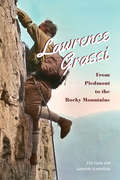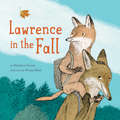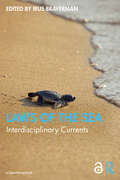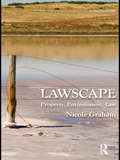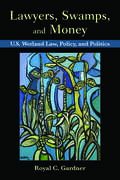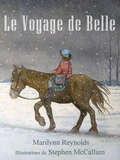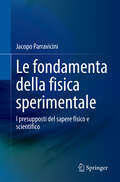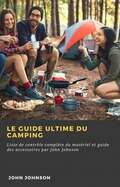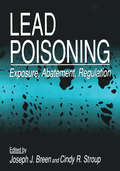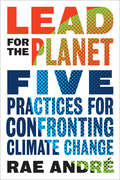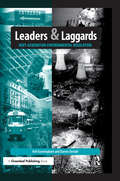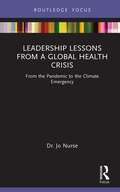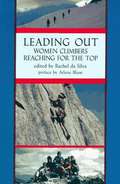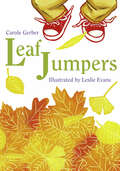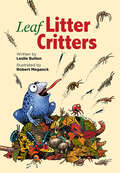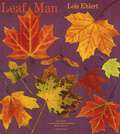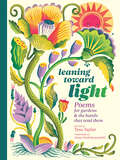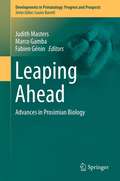- Table View
- List View
Law, Policy and Climate Change: The Regulation of Systemic Risks
by Dariel De SousaFocusing on systemic risks caused by climate change, this book examines how these risks can be effectively regulated to ensure resilience and avoid catastrophe. Systemic risks are risks that threaten the systems upon which society depends, including ecosystems, social systems, financial systems, and systems of infrastructure. Such risks are typically characterised by inherent complexity, profound uncertainty, and overwhelming ambiguity. In combination, these features pose significant regulatory challenges for policy and law-makers. Examining how different types of systemic risks caused by climate change are being regulated in four different jurisdictions – the EU, the UK, the US and Australia – this book identifies deficiencies associated with regulating systemic risks using a traditional approach, based on a linear relationship between risk and regulation, which is widely used to regulate risk. The book advances a regulatory approach that is, instead, founded on the concept of "risk governance". This involves a structured yet flexible, holistic, interdisciplinary and inclusive basis for responding to systemic risks; and it is, this book argues, a more effective basis for regulating systemic risks given their uncertainty, complexity and ambiguity. This book will appeal to academics, policy and law-makers and practitioners working at the intersection of law and policy in the areas of regulation, risk management and climate change.
Law, Property and Disasters: Adaptive Perspectives from the Global South
by Daniel Fitzpatrick Caroline ComptonThis book re-considers property law for a future of environmental disruption. As slogans such as “build the wall” or “stop the boats” affect public policy, there are counter-questions as to whether positivist or statist notions of property are fit for purpose in a time of human mobility and environmental disruption. State-centric property laws construct legal fictions of sovereign control over land, notwithstanding the persistent reality of informal settlements in many parts of the Global South. In a world affected by catastrophic disasters, this book develops a vision of adaptive governance for property in land based on a critical re-assessment of state-centric property law. This book will appeal to a broad readership with interests in legal theory, property law, adaptive governance, international development, refugee studies, postcolonial studies, and natural disasters.
Law, Space, and the Vehicular Environment: Pavement and Asphalt
by Sarah MarusekThis book examines the paved road as a liminal space and legal frontier for enlivened, everyday struggles over property, power, and place/definition. Through pavement itself and the pavement-based practices of pavementalities and pavementeering, the road is legally framed as a place for movement. Paved terrain is a site of dynamism between law and place that engenders the road as legal metaphor by calling forth the kinetic notion of jurisprudence in which law can be understood through the fluidity of everyday life. In Western (and particularly American) society, roads are a material locus of governance, in which rights of way are determined, communicated, and enforced. However, roads also constitute a site of resistance or disruption, beyond regulation. Addressing phenomena such as travel, political protest, public memory, and community governance, this book explores the paved medium of asphalt as a complex surface for legality that constitutively frames order against disorder involving jurisdiction tensions, property ownership, and cultural identities in vehicular environments. The target audience of this book are those students and scholars who consider how law works in society, whether through frameworks of (auto) mobility and legal geography or through the interdisciplinary approaches of legal semiotics, legal culture, and/or new materialism.
Law, Tropical Forests and Carbon
by Rosemary Lyster Catherine MacKenzie Constance Mcdermott Rosemary Lyster Catherine MackenzieEmerging from the scientific parameters underpinning REDD+ (including the measurement of carbon stocks, reporting and verification), Law, Tropical Forests and Carbon considers the crucial challenges for global and national governance and the legal rights and interests of indigenous people and local communities, all of which have fundamental implications for development and poverty alleviation. With contributions from leading experts in the fields of law, governance, science, development studies and geography, it sheds light on the complexity of REDD+ and offers perspectives on the extent to which REDD+ agreements can be enforced under international law and in concert with new private and public domestic institutions.
Lawrence Grassi
by Gabriele Scardellato Elio CostaLawrence Grassi was a trailblazer in every sense of the word. A working-class man of humble Italian origins who worked as a labourer and a coal miner for most of his life, Grassi had a deep passion for the Rocky Mountains. He was famous in the region for his commitment as a guide, a mountain climber, and a builder of greatly admired hiking trails. Today, in or near Canmore, his name graces a mountain, two lakes, and a school, and he is commemorated at Lake O'Hara in Yoho National Park.In Lawrence Grassi: From Piedmont to the Rocky Mountains, Elio Costa and Gabriele Scardellato uncover the deeply private man behind this legend, from his birth in the small Italian village of Falmenta to his long and inspirational career in Canada. Using previously unexamined family letters and extensive information on Grassi's cohort of Italian immigrants, the authors reconstruct his personal and professional life, correcting myths and connecting his story to the long history of Italian immigration to Canada. The definitive biography of this Canadian mountain hero, Lawrence Grassi will be essential reading for those interested in the history of immigration, sport, and the Rocky Mountains.
Lawrence in the Fall
by Matthew FarinaWhen Lawrence Fox's teacher announces that students will be presenting their collections at show-and-tell, Lawrence realizes he doesn't have anything to share.Luckily, Papa knows just what to do to help! Together, they venture into the woods. Lawrence is scared at first, but as he grows comfortable in the forest, he starts to recognize its magic, and how beautiful and unique each tree and leaf is, allowing him to gather a splendid, one-of-a-kind collection of his own!
Laws of the Sea: Interdisciplinary Currents
by Irus BravermanLaws of the Sea assembles scholars from law, geography, anthropology, and environmental humanities to consider the possibilities of a critical ocean approach in legal studies. Unlike the United Nations’ monumental Convention on the Law of the Sea, which imagines one comprehensive constitutional framework for governing the ocean, Laws of the Sea approaches oceanic law in plural and dynamic ways. Critically engaging contemporary concerns about the fate of the ocean, the collection’s twelve chapters range from hydrothermal vents through the continental shelf and marine genetic resources to coastal communities in France, Sweden, Florida, and Indonesia. Documenting the longstanding binary of land and sea, the chapters pose a fundamental challenge to European law’s “terracentrism” and its pervasive influence on juridical modes of knowing and making the world. Together, the chapters ask: is contemporary Eurocentric law—and international law in particular—capable of moving away from its capitalist and colonial legacies, established through myriad oceanic abstractions and classifications, toward more amphibious legalities? Laws of the Sea will appeal to legal scholars, geographers, anthropologists, cultural and political theorists, as well as scholars in the environmental humanities, political ecology, ocean studies, and animal studies.
Laws, Theories, and Patterns in Ecology
by Walter K. DoddsIntroductory material describes how the practice of science in general, and ecology specifically, yields theories and laws. Dodds also discusses why such ideas are only useful if they have predictive ability, and delineates the scope of these generalizations and the constraints that limit their application.
Lawscape: Property, Environment, Law
by Nicole GrahamLawscape: Property, Environment, Law considers the ways in which property law transforms both natural environments and social economies. Addressing law's relationship to land and natural resources through its property regime, Lawscape engages the abstract philosophy of property law with the material environments of place. Whilst most accounts of land law have contributed cultural analyses of historical and political value predominantly through the lens of property rights, few have contributed analyses of the natural consequences of property law through the lens of property responsibilities. Lawscape does this by addressing the relationship between the commodification of land, instituted in and by property law, and ecological and economic histories. Its synthesis of property law and environmental law provides a genuinely transdisciplinary analysis of the particular cultural concepts and practices of land tenure that have been created, and exported, across the globe.
Lawyers, Swamps, and Money: U.S. Wetland Law, Policy, and Politics
by Royal C GardnerLawyers, Swamps, and Money is an accessible, engaging guide to the complex set of laws governing America's wetlands. After explaining the importance of these critical natural areas, the book examines the evolution of federal law, principally the Clean Water Act, designed to protect them. Readers will first learn the basics of administrative law: how agencies receive and exercise their authority, how they actually make laws, and how stakeholders can influence their behavior through the Executive Branch, Congress, the courts, and the media. These core concepts provide a base of knowledge for successive discussions of: the geographic scope and activities covered by the Clean Water Act the curious relationship between the U.S. Army Corps of Engineers and the Environmental Protection Agency the goal of no net loss of wetlands the role of entrepreneurial wetland mitigation banking the tension between wetland mitigation bankers and in-lieu fee mitigation programs wetland regulation and private property rights. The book concludes with insightful policy recommendations to make wetlands law less ambiguous and more effective. A prominent legal scholar and wetlands expert, professor Royal C. Gardner has a rare knack for describing landmark cases and key statutes with uncommon clarity and even humor. Students of environmental law and policy and natural resource professionals will gain the thorough understanding of administrative law needed to navigate wetlands policy-and they may even enjoy it.
Le Japon Artistique: Japanese Floral Pattern Design in the Art Nouveau Era
by Museum of Fine Arts, BostonEnchanting floral imagery from Boston&’s Museum of Fine Arts to inspire anyone who loves art and design. Celebrating an era of dynamic and creative cross-pollination between Japanese design and European Art Nouveau at the turn of the last century, Le Japon Artistique features stunning floral imagery drawn from a variety of rare books held in the collection of the Museum of Fine Arts, Boston. Seldom seen outside the museum context, these lush botanical motifs are as visually enchanting as they are significant in the arc of Japanese art history—and this volume serves as both a reference for artists and a treat for art and design lovers in springtime or any season.
Le Voyage de Belle
by Marilynn ReynoldsBelle est devenue trop vieille et trop raide pour tirer les charrues ou les chariots. Le cheval de Molly ne gagne plus sa pitance qu’en emmenant la jeune fille à ses leçons de piano une fois par semaine. Quand le père de Molly en conclut qu’il est temps de vendre Belle, Molly est ravie à l’idée qu’elle galopera bientôt sur un beau jeune poney. Mais un jour d’hiver, en revenant de ses leçons, Molly et Belle se perdent dans un immense blizzard sorti de nulle part. Et Belle, malgré son âge, affronte la terrible tempête avec une volonté de fer. Quoi qu’il arrive, Belle n’abandonnera pas tant qu’elle n’aura pas ramené sa jeune cavalière à la maison. Le voyage de Belle se passe dans les Prairies canadiennes pendant les années 1920. C’est une histoire émouvante de dévouement sans faille et d’un combat héroïque pour la survie.
Le fondamenta della fisica sperimentale: I presupposti del sapere fisico e scientifico
by Jacopo ParraviciniQuesto libro ha lo scopo di fornire un’ampia riflessione sui principi generali della fisica e gli elementi fondanti della conoscenza scientifica nella loro unitarietà. Sfruttando largamente il pensiero di molti tra i più grandi scienziati, esso offre una chiara comprensione dei fondamenti della fisica e del suo metodo sperimentale, ponendo in risalto le correlazioni tra i principali eterogenei elementi che vi stanno alla base. Si ricorda come le scienze sperimentali non siano statiche ma, al contrario, soggette a continui studi e ripensamenti. Nell'affrontare la mancanza di lezioni o trattazioni sistematiche sulla natura del metodo scientifico nei tradizionali corsi universitari tecnico-scientifici, l'autore si addentra così nello studio di ciò che sta alla base della scienza in generale, e della fisica in particolare. Sono trattati temi quali la relazione tra fenomeni naturali e il linguaggio matematico, mettendo in risalto i principali snodi dello sviluppo concettuale nella scienza. Inoltre l’autore discute l’importanza della “pratica scientifica” sottolineandone il ruolo nell’avanzamento della conoscenza scientifica, e il modo con cui essa contribuisce alla fisica nel suo complesso. Il libro è suddiviso in tre parti, ciascuna delle quali copre differenti aspetti della fisica e dei suoi fondamenti: la prima parte riguarda le radici fenomenologiche e gli strumenti basilari della disciplina; la seconda si concentra sulla struttura della conoscenza scientifica; la terza tratta i metodi pratici dell’indagine scientifica. Il libro rimane accessibile per qualsiasi studente di discipline tecnico-scientifiche, poiché un non fisico sarà agevolmente in grado di trovare facilmente in libri di testo di natura introduttiva spiegazioni di quei concetti fondamentali dati per assodati.
Le guide ultime du camping: Liste de contrôle complète du matériel et guide des accessoires par John Johnson
by John JohnsonLe guide ultime du camping : Liste de contrôle complète du matériel et guide des accessoires par John Johnson Découvrez comment vous débuter, tout ce que vous devez savoir sur ce sport et comment camper comme un pro. Le guide ultime du camping : liste de contrôle complète du matériel et guide des accessoires Vous souhaitez vous lancer dans le camping ? Vous voulez apprendre à camper comme les pros ?¤ Si vous avez répondu oui à ces questions, ce livre est pour vous. Découvrez comment vous débuter, tout ce que vous devez savoir sur ce sport et comment camper comme un pro. L'utilisation de ces techniques et conseils de camping vous aidera à vous lancer et à camper mieux que jamais ! Découvrez les secrets que les professionnels utilisent pour s’adapter aux terrains les plus difficiles ! Avec des décennies de stratégies testées, ce livre électronique vous montrera la façon la plus rapide et la plus efficace d'apprendre ce sport ! Sont inclus : - Pour commencer. - Liste de contrôle. - Quel matériel utiliser. - Comment camper. - Préparation. + ET BIEN PLUS ENCORE ! Si vous voulez être plus fort et plus efficace au camping, alors ce guide est pour vous. --> Faites défiler jusqu'en haut de la page et cliquez sur ajouter au panier pour acheter instantanément
Lead Poisoning: Exposure, Abatement, Regulation
by Joseph J. Breen Cindy R. StroupLead Poisoning discusses one of the most critical and preventable environmentally induced illnesses. The actual toll lead poisoning takes on society cannot be measured fully due to the "silent" nature of health effects, such as subtle intellectual deficits and neurological damage, caused by chronic low-level exposures. This book covers every major topic on the subject, including lead poisoning in children, sources of contamination, state-of-the-art sampling and analytical measurement methods, the newest studies on low-cost abatement methods, and much more. This reference is the most comprehensive presentation of issues currently available under one cover.The text is divided into three major parts. Part I provides insights from studies assessing lead exposures from paint, dust, soil, and lead battery recycling operations. The second part is a unique collection of strategic federal policy statements from the U.S. EPA, HUD, and HEW-CDC. It details the National Implementation Plan as well as a local government's efforts to provide low-cost effective risk communication and public outreach to the community. The next part offers seven chapters on analytical issues in the measurement of lead in blood, paint, dust, and soils. Part IV, Sampling Methods and Statistical Issues, rounds out the technical portion of the volume. The relationships among lead levels in biological and environmental media are investigated and the interpretive problems discussed. The use of multi-element analysis of environmental samples as an approach to investigate sources is described.The book finishes with its most unique feature-OPPT's Check Our Kids for Lead Program, one organization's effort to empower its employees to make a personal difference in confronting the problem of lead poisoning in children. The Program serves as a model for other government organizations (federal, state, and local), university and community organizations, and corporations to educate them and take personal and corporate responsibility for addressing this important and environmental health problem.
Lead for the Planet: Five Practices for Confronting Climate Change
by Rae AndreWith melting ice caps in the Arctic causing catastrophic environmental issues, it’s hard to believe that we’ve had to spend so much time convincing each other that climate change is real. Lead for the Planet shifts the focus to how we, the members of Team Humanity, are going to organize to solve the twin issues of climate change and energy evolution. The book channels a broad range of social science perspectives, from anthropology to psychology to economics, to help decision-makers explore how Team Humanity can get this thing done. Lead for the Planet outlines five practices that successful climate leaders will need to adopt, from getting the truth about the state of the planet, to assessing the risks and identifying the interests of key stakeholders, to implementing change within and between organizations and sectors on a global scale. Building on her experience as an organizational psychologist, Rae André shows how these practices comprise an effective model for climate leadership. Lead for the Planet is a guide for the kind of leadership that is necessary to help us all avoid the worst of global warming and to create a clean energy future for the generations to come.
Leaders and Laggards: Next-Generation Environmental Regulation
by Darren Sinclair Neil GunninghamConsensus is growing internationally that traditional command-and-control approaches to environmental regulation have borne much of their low-hanging fruit. Yet it is far from clear what should complement or replace them. Regulatory agencies and policy-makers are struggling with a lack of information about regulatory reform, about what works and what doesn't, and about how best to harness the resources of both government and non-government stakeholders. Progress is being impeded unnecessarily by a lack of shared knowledge of how similar agencies elsewhere are meeting similar challenges and by a lack of data on the success or otherwise of existing initiatives. Despite recent and valuable attempts to deal with such problems in the European Union and North America, these remain islands of wisdom in a sea of ignorance. For example, when it comes to dealing with small and medium-sized enterprises, very little is known, and what is known is not effectively distilled and disseminated. Much the same could be said about the roles of third parties, commercial and non-commercial, as surrogate regulators, and more broadly of many current initiatives to reconfigure the regulatory state. Based on the authors' work for the OECD, Victorian Environmental Protection Authority and the Western Australian Department of Environment Protection, Leaders and Laggards addresses these problems by identifying innovative regulatory best practice internationally in a number of specific contexts, evaluating empirically the effectiveness of regulatory reform and providing policy prescriptions that would better enable agencies to fulfil their regulatory missions. Focusing primarily on the differing requirements for both corporations and small and medium-sized enterprises in North America and Europe, the book aims to complement existing initiatives and to expand knowledge of regulatory reform by showing: how existing experience can best be put to practical use "on the ground"; by drawing lessons from experiments in innovative regulation internationally; by reporting and extrapolating on original case studies; and by advancing understanding on which instruments and strategies are likely to be of most value and why. The authors argue that the development of theory has outstripped its application. In essence, Leaders and Laggards aims to ground a myriad of theory on the reinvention of environmental regulation into practice. The book will be essential reading for environmental policy-makers, regulatory and other government officials responsible for policy design and implementation, academics and postgraduate students in environmental management, environmental law and environmental policy, and a more general readership within environmental policy and management studies. It will also be of interest to those in industry, such as environmental managers and corporate strategists, who are considering the use of more innovative environmental and regulatory strategies, and to environmental NGOs.
Leadership Lessons from a Global Health Crisis: From the Pandemic to the Climate Emergency (Routledge Focus on Environmental Health)
by Jo NurseThis book explores the key learning for global leadership in the face of modern international health crises and argues the need for fundamental reform to governance paradigms, within the global security sphere and policymaking circles. Beginning with an analysis of the worldwide response to the COVID-19 pandemic, the book provides insights from evolution, history, and human behaviour to explain how our current leadership paradigms have contributed to today’s global health challenges, and draws lessons for the much larger crisis of climate change with the threat of massive biodiversity collapse. The second part of the book outlines tangible solutions to transform leadership and policy to enhance global security for both People and the Planet, with the aim of averting future Pandemics and our Planetary Emergency. This book: Will be among the first published works to examine the international response to the COVID-19 pandemic, and draws valuable lessons for our Climate Crisis. Directly addresses the nexus between scientific advice and policymaking, highlighting its need for remedial action in the wake of 2020 global health crises. Provides a bridge between public health, the environment and leadership. This book will prove an insightful resource for current and future world leaders, politicians and policymakers, as well as Environmental and Public Health professional bodies, think tanks and institutions shaping the next generation of leadership.
Leadership in Leisure Services: Making a Difference (Third Edition)
by Debra J. JordanLeadership is a process and an experience that impacts all of us in our roles as leaders and as followers. This text presents leadership as a personal journey that takes conscious effort to undertake and develop. Leadership is one of the keystones of successful parks, recreation and leisure services agencies, organizations and programs. How we deal with people,how we interact with fellow staff supervisors, participants, and the general public all make an incredible statement about who we are and what our profession is about. This book is designed to help students of leadership begin, or renew, their personal journey toward leadership.
Leading Out: Women Climbers Reaching for the Top
by Rachel Da SilvaLeading Out is a valuable collection of inspiring essays by the most prominent and impassioned women climbers in recent history. A real tribute to the efforts and dedication of the women who have struggled to pursue their passion for climbing.
Leaf Jumpers
by Carole GerberThis vibrant poem celebrates the beauty of autumn while inviting us all to go ahead and jump in that big, colorful, pile of fall leaves. Leslie Evan&’s bold artwork brings together gold, orange, yellow, red, and brown leaves into a literary pile creating the magic of autumn for young readers. The poetic text gives simple facts about different types of fall leaves making it easy for readers to identify leaves ranging from red maple to sycamore by color, shape, and other characteristics. Informative and fun, Carole Gerber brings us a wonderful introduction to seasons and science for the earliest of leaf jumpers.
Leaf Litter Critters
by Leslie BulionTake a poetic tour through the duff and get the dirt on the tiny, fascinating critters that live there.For all the kids who can't resist turning over a rock, science poetry maven Leslie Bulion presents nineteen lively ecological poems in a variety of verse forms about the "brown food web" and the creatures that live there—from bacteria and rove beetles to mushrooms and millipedes, and all of the other busy recyclers in between. Illustrator Robert Meganck adds to the fun with humorous and vivid, yet scientifically detailed, artwork. Science notes run throughout for added context, and thorough back matter includes a glossary, poetry notes, hands-on investigations, and other resources for cross-curricular learning.
Leaf Man
by Lois EhlertRide the wind and drift east with Leaf Man in this autumnal classic by Caldecott Honor-winning author-illustrator Lois Ehlert, perfect for young readers returning to school in the fall. Fall has come, the wind is gusting, and Leaf Man is on the move. Is he drifting east, over the marsh and ducks and geese Or is he heading west, above the orchards, prairie meadows, and spotted cows? No one's quite sure, but this much is certain: A Leaf Man's got to go where the wind blows. Ehlert crafts each illustration out of actual fall leaves on every spread to reveal gorgeous landscapes. This playful and whimsical book celebrates the natural world and the rich imaginative life of children.
Leaning toward Light: Poems for Gardens & the Hands That Tend Them
by Edited by Tess TaylorThis beautiful poetry anthology offers a warm, inviting selection of poems from a wide range of voices that speak to the collective urge to grow, tend, and heal—an evocative celebration of our connection to the green world. Caring for plants (much like reading a good poem) brings comfort, solace, and joy to many—offering an outlet in difficult times to slow down and steward growth. In Leaning toward Light, acclaimed poet and avid gardener Tess Taylor brings together a diverse range of contemporary voices to offer poems that celebrate that joyful connection to the natural world. Several of the most well-known contemporary writers, as well as some of poetry&’s exciting rising stars, contribute to this collection including Ross Gay, Jericho Brown, Mark Doty, Jane Hirshfield, Ada Limón, Danusha Laméris, Naomi Shihab Nye, Garret Hongo, Ellen Bass, and James Crews. Select poems are paired with reflective pauses and personal recipes from the authors, and colorful illustrations are featured throughout. Plus, the gorgeous hardcover package with ribbon bookmark makes this anthology a distinctive gift. Gardening offers a rich and expansive subject, with poems moving thematically through the year from planting and weeding to harvesting and eating. Poets find purpose in browsing a seed catalog and comfort in picking green tomatoes despite California&’s wildfire season raging on—reminding us how gardening is a healing practice, both for ourselves and the spaces we tend. The range of experience reflected, from caring for a few houseplants to an expansive garden or farm, offers wide appeal and illuminating insights for gardeners, plant lovers, or anyone interested in connecting more deeply with the earth. This publication conforms to the EPUB Accessibility specification at WCAG 2.0 Level AA.
Leaping Ahead
by Fabien Génin Russell Tuttle Marco Gamba Judith MastersLeaping Ahead: Advances in Prosimian Biology presents a summary of the state of prosimian biology as we move into the second decade of the 21st century. The book covers a wide range of topics, from assessments of diversity and evolutionary scenarios, through ecophysiology, cognition, behavioral and sensory ecology, to the conservation and survival prospects of this extraordinary and diverse group of mammals. The collection was inspired by an international conference in Ithala, KwaZulu-Natal, South Africa in 2007, where prosimian biologists gathered from Canada, Finland, France, Germany, India, Italy, Japan, Madagascar, South Africa, Tanzania, the United Kingdom, and the United States of America. The meeting reverberated with the passion prosimian researchers feel for their study subjects and with their deep concern for the future of prosimians in the face of ongoing habitat destruction and the burgeoning threat of bushmeat hunting. Chapters for this volume were contributed by researchers from across the globe; they attest to the diversity, vibrancy and rapid growth of prosimian biology, and to the intellectual advances that have revolutionized this field in recent years. Since its earliest beginnings, prosimian research and its resultant literature have had a strong francophone component, and researchers in many prosimian habitat countries are more comfortable reading and writing in French rather than English. French summaries of all chapters have been included. The volume is targeted at researchers, both those entering the field and established scientists, who have an interest in the biology of primates and small mammals. It is also aimed at conservation biologists seeking a deeper understanding of the faunas and conservation developments in Africa, Madagascar and Southeast Asia, and anyone who has an interest in discovering the true diversity of our order, the Primates.
